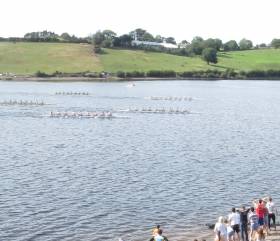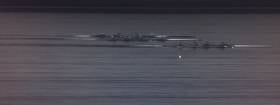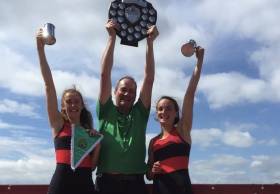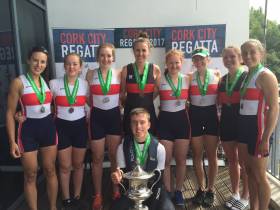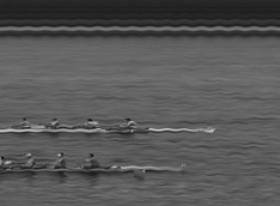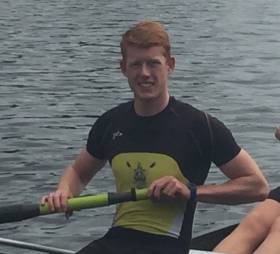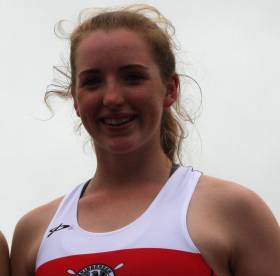Displaying items by tag: Irish Rowing Championships
#Rowing: The big crowds saw a close and exciting senior men’s eight final at the Irish Rowing Championships. Commercial carved out a small lead early on, and despite pressure from NUIG and Skibbereen, they held on to win.
In the women’s senior eights final, UCD/Old Collegians had to wait until the middle stages to take over in the lead, but once they did they built and built on it. They had over three seconds at the finish over Skibbereen/UCC.
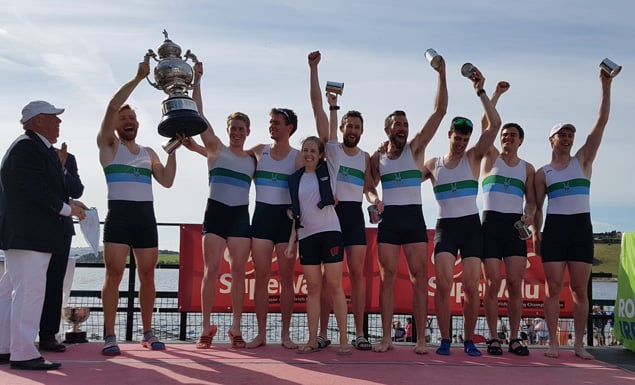 Winners of senior men’s eights (Commercial)
Winners of senior men’s eights (Commercial)
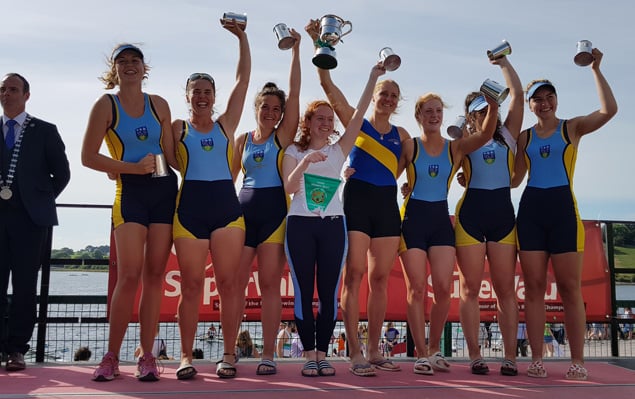 Winners of senior women’s eights (UCD/Old Collegians – Claire Lambe not included)
Winners of senior women’s eights (UCD/Old Collegians – Claire Lambe not included)
NUIG took their ninth title as they lifted the women’s club eight, while Enniskillen brought a very successful end to a good regatta for them by taking the men’s junior pair through Aaron Johnston and Nathan Timoney.
Three Castles also had a fruitful Championships and their junior quadruple won.
Lee and Clonmel won the women’s junior quad and the men’s intermediate double respectively and Bann’s Hannah Scott took the women’s intermediate single sculls title.
Irish Rowing Championships, National Rowing Centre, Day Three (Selected Results)
Men
Eight – Senior: 1 Commercial 5:46.04, 2 Skibbereen 5:47.95, 3 NUIG 5:48.39. Novice: Queen’s 6:21.56.
Four – Club, coxed: NUIG A 6:43.38.
Pair – Inter: NUIG 6:56.09. Junior: Enniskillen B 6:52.04.
Sculling, Quadruple – Junior: 1 Three Castles 6:21.53, 2 Shandon 6:22.75, 3 Clonmel 6:23.05.
Double – Inter: Clonmel 6:37.17. Junior: Three Castles A 6:50.22.
Single – Lightweight: Skibbereen (G O’Donovan) 7:22.32. Inter: Clonmel (D Lynch) 7:10.25.
Women
Eight – Senior: 1 UCD/Old Collegians 6:24.84, 2 Skibbereen/UCC 6:27.96, 3 NUIG/Cork 6:33.67. Club: NUIG 6:46.97.
Four – Inter, coxed: NUIG 7:23.65.
Pair – Senior: UCD (A Crowley, E Lambe) 7:37.41. Junior: Fermoy 7:53.37.
Sculling, Quadruple – Junior: Lee 6:54.96.
Single – Senior: Old Collegians (S Pupsure) 8:02.64. Lightweight: Skibbereen (D Walsh) 8:09.96. Inter: Bann (H Scott) 7:55.58. Club One: Carlow (C Nolan) 8:15.22.
Big Win for UCD's Crowley and Lambe At Rowing Championships
#Rowing: UCD’s Eimear Lambe and Aileen Crowley had an impressive win in the women’s senior pair in the deferred finals at the start of the third day of the Irish Championships at the National Rowing Centre. Skibbereen and Cork were in the touch with the UCD women until 1500 metres, but Lambe and Crowley left the rest behind from there and won by 10 seconds from Skibbereen.
Queen’s were also impressive in their win in the men’s novice eight, and Sanita Puspure won the senior single sculls with plenty to spare.
The junior 16 men’s eight went to Enniskillen, who thus completed the set of wins: the junior 18 and 16 eights for men and women.
Irish Rowing Championships, National Rowing Centre, Day Three (Selected Results)
Men
Eight – Novice: Queen’s 6:21.56.
Sculling, Quadruple – Junior: 1 Three Castles 6:21.53, 2 Shandon 6:22.75, 3 Clonmel 6:23.05.
Women
Pair – Senior: UCD (A Crowley, E Lambe) 7:37.41.
Sculling, Single – Senior: Old Collegians (S Pupsure) 8:02.64.
#Rowing: Three Castles won a thrilling final of the men's junior quadruple sculls at the Irish Rowing Championships this morning. They had just a second to spare over Shandon, who were just ahead of Clonmel. The crew of Aaron Keogh, who is the youngest, Tadgh McKnight, Rory Quinn and Oisin Clune were the first winners of the day, as theirs was one of the finals deferred from the Saturday session.
Irish Rowing Championships, National Rowing Centre, Day Three (Selected Results)
Men
Junior Quadruple: 1 Three Castles 6:21.53,
2 Shandon 6:22.75
3 Clonmel 6:23.05
High Winds Force Postponement at Irish Rowing Championships
#Rowing: High winds forced the suspension or rowing for the rest of Saturday at the Irish Rowing Championships. The organisers stopped the action on the water in the afternoon and set to redesigning the programme so that key races set for the rest of Saturday will be held on Sunday. Finals of important events such as the women’s senior pair and senior single and the men’s novice eight are set to be held before eight o’clock on Sunday.
Early Movers Take Spoils at Irish Rowing Championships
#Rowing: On a morning of clear victories, David Higgins of Presentation Boat Club, Cork, had to battle to see off Luke Hayes-Nally of Shandon to take the Club Singles title at the National Rowing Centre.
The other wins in the Saturday morning session of the Irish Rowing Championships followed the pattern of one crew gaining an early lead and winning well. Mark O’Donovan and Shane O’Driscoll in the pair; NUIG in the women’s novice eight; Enniskillen in the men’s junior coxed four and Cork Boat Club’s Lisa Dilleen and Chloe Mehigan in the women’s intermediate double all came home well clear of the field.
Hannah Scott made her move so early that she had three-quarters of the junior single sculls final as clear leader. Margaret Cremen held off Aoife Casey for second.
The men’s intermediate eight final was a UCD affair – their A crew beat their B crew in a tight finish.
Irish Rowing Championships, Day Two (Selected Results)
Men
Eight – Intermediate: UCD 5:50.02.
Four – Junior, coxed: Enniskillen 6:22.94.
Pair – Senior: Skibbereen 6:59.69.
Sculling, Single – Club: Cork (D Higgins) 7:26.59.
Women
Eight – Novice: NUIG 6:38.95.
Sculling, Double – Intermediate: Cork 7:09.95.
Single – Junior: Bann (H Scott) 7:41.22.
#Rowing: Skibbereen added four titles to their already weighty tally on the first day of the Irish Rowing Championships at the National Rowing Centre today. Paul O’Donovan won the senior single sculls and teamed up with Mark O’Donovan, Shane O’Driscoll and his brother Gary in the senior four – both were done in new record times for the course. Paul and Gary also won the senior doubles. The Skibbereen women’s four also won well, in a new best time for the course.
NUIG also took four titles: the men’s intermediate coxed four and club eight and the women’s club coxed four and novice coxed quadruple.
Cork Boat Club proved best in the women’s intermediate eight and also won perhaps the best race of the day: Barry O’Flynn was severely tested by Jack Dorney in the junior single sculls but fought back after being passed and won by a length.
The Old Collegians victory in the women’s senior double was straightforward: Sanita Puspure and Claire Lambe were by far the best crew.
This was the last final of the day, while UCC had won the first, taking the men’s novice coxed quadruple.
Neptune and St Joseph’s tried to rein them in, but the men’s junior eights final was a surprsingly straightforward affair for winners Enniskillen, who also won the women’s junior four. Lee’s Margaret Cremen and Aoife Lynch were also in control in the women’s junior double, as were Hannah Scott and Katie Shirlow in the intermediate pair.
Irish Rowing Championships, National Rowing Centre, Day One (Selected Results)
Men
Eight – Club: NUIG 5:53.60. Junior: Enniskillen 5:47.96.
Four – Senior: Skibbereen 5:55.33. Inter, coxed: NUIG 6:13.38.
Sculling, Quadruple – Novice, coxed: UCC 6:39.37.
Double – Senior: Skibbereen 7:06.89.
Single – Senior: Skibbereen (P O’Donovan) 6:48.19. Junior: Cork (B O’Flynn) 7:04.06.
Women
Eight – Intermediate: Cork 6:22.06.
Four – Senior: Skibbereen 6:40.58. Club, coxed: NUIG 7:10.92. Junior: Enniskillen 6:57.94.
Pair – Inter: Bann 7:19.32.
Sculling, Quadruple – Novice, coxed: NUIG 7:36.02. Double – Senior: Old Collegians 6:59.997. Junior: Lee 7:09.86.
Stars Come Out for Huge Irish Rowing Championships
#Rowing: A bumper weekend of racing is in store in Cork as the 2017 Irish Rowing Championships take place at the National Rowing Centre from Friday, July 14th to Sunday, July 16th. The event will showcase some of the best rowing Ireland has to offer with 1049 crews competing in 264 races.
The National Rowing Centre will welcome 60 clubs, including Waterville and Flesk Valley, who will compete at the Championships for the first time, as well as a re-formed Newry Rowing Club.
High Performance athletes including Gary and Paul O’Donovan, Sanita Puspure and Claire Lambe will be among those competing for the much coveted “Pots”, as well as European Champions Shane O’Driscoll and Mark O’Donovan, and European Silver medallist Denise Walsh.
Three superb days of racing were enjoyed at last year’s Championships, which came to a spectacular end with the men’s senior eights being fought right to the line. Commercial Rowing Club came away with the “Big Pot” in the end after a thrilling race, which saw them finishing less than a second ahead of rivals UCD.
Skibbereen, in combination with UCC, won the women’s senior eight. That win took Skibbereen’s overall tally for the Championships to 13 – they now have 163 titles in total, 11 clear of nearest rivals, Neptune (152).
Commercial the Senior Eights Rowing Champions of Ireland
#Rowing: Commercial won the senior eights championship of Ireland (the 'Big Pot') in a race with a thrilling finish at the Irish Rowing Championships. The Dublin crew took over the lead at halfway, but could not shake off UCD. In the final 250 metres, UCD charged and seemed set to catch Commercial, but the eventual winners found something and surged. The margin in an extremely fast race - Commercial recorded a time of five minutes 36.892 seconds - was less than a third of a second.
Skibbereen, in combination with UCC, won the women's senior eight. This was a much more emphatic win, with UCD challenging but not able to catch the winners. Skibbereen added the women's junior quadruple and the men's intermediate double titles to take their overall tally for the Championships to 13 - they now have 163 in total, 11 clear of nearest rivals, Neptune (152).
Marie Piggott of NUIG was a very clear winner of the women's intermediate single. Commercial were also in charge in their win in the men's junior pair.
Cork completed a good set of results for them when they won the women's club eight.
Irish Rowing Championships, National Rowing Centre, Day Three (Selected Results, Finals)
Men
Eights - Senior: 1 Commercial (D Joyce, M Maher, R Peguet, S Mac Eoin, F Groome, D Burke, C Dowling, N Gahan; cox: M Crockett) 5:36.892, 2 UCD A 5:37.220, 3 NUIG 5:44.377. Four - Club, coxed: NUIG 6:33.156.
Pair - Inter: Portora 6:49.900. Junior: 1 Commercial 7:00.686, 2 Portora B 7:02.186, 3 Portora A 7:03.905.
Sculling, Double - Inter: Skibbereen 6:33.887. Junior: 1 Shandon A 6:36.777, 2 Clonmel 6:39.324, Castleconnell A 6:51.168.
Lightweight Single: 1 Skibbrereen (S O'Driscoll) 7:15.482, 2 Skibbereen (A Burns) 9:08.433, 3 Carlow (O Nolan) 7:36.764.
Women
Eight- Senior: 1 Skibbereen/UCC (L Murphy, N Casey, O Hayes, C J Hearne, N O'Mahony, A Feeley, A Keogh, D Walsh; cox R O'Leary) 6:24.548, 2 UCD 6:29.778, 3 Trinity 6:40.377. Club: Cork 6:39.339.
Four - Inter, coxed: Commercial 7:20.348.
Pair - Junior: 1 Cork 7:35.640, 2 Bann 7:41.453, 3 Shannon 7:41.750
Sculling - Quadruple - Junior: 1 Skibbereen 6:46.308, 2 Bann 6:53.292, 3 Lee 6:59.527.
Single - Inter: NUIG (M Piggott) 7:58.822.
Lightweight Single: Skibbereen (D Walsh) 7:54.535, 2 Carlow (A Byrne) 8:21.130, 3 Queen's (R Brown) 8:33.287.
#Rowing: Skibbereen brought their tally of titles for the Irish Rowing Championships to a remarkable 10 so far as Denise Walsh and Shane O'Driscoll had big wins in the lightweight single sculls in the morning session of the third day.
Shandon's win in the men's junior double was a sweet one for Stephen O'Sullivan and Ronan Byrne. They led Clonmel all down the course and held off push after push in the final 500 metres. Strokeman O'Sullivan shouted with joy at the finish, but it was a particularly big win for Byrne. He had been beaten by the Clonmel strokeman, Daire Lynch, in the junior single. Byrne and Lynch team up in the Ireland junior double for the World Championships.
Cork Boat Club's good run in junior events continued, as Amy Mason and Tara Hanlon won the junior pair. Portora won the men's intermediate pair and NUIG the club coxed four. Commercial led all the way in the women's intermediate four and had a clearwater margin at the finish.
Irish Rowing Championships, National Rowing Centre, Day Three (Selected Results, Finals)
Men
Four - Club, coxed: NUIG 6:33.156.
Pair - Inter: Portora 6:49.900.
Sculling, Double - Junior: 1 Shandon A 6:36.777, 2 Clonmel 6:39.324, Castleconnell A 6:51.168.
Lightweight Single: 1 Skibbrereen (S O'Driscoll) 7:15.482, 2 Skibbereen (A Burns) 9:08.433, 3 Carlow (O Nolan) 7:36.764.
Women
Four - Inter, coxed: Commercial 7:20.348.
Pair - Junior: 1 Cork 7:35.640, 2 Bann 7:41.453, 3 Shannon 7:41.750
Sculling - Lightweight Single: Skibbereen (D Walsh) 7:54.535, 2 Carlow (A Byrne) 8:21.130, 3 Queen's (R Brown) 8:33.287.
Cork Four Beat Portora at Irish Rowing Championships
#Rowing: Cork Boat Club won the men's junior 18 coxed four at the National Rowing Championships today. On Friday, Portora had beaten Cork in the junior eight by leading all the way, but Cork turned the tables - they took the lead early and won by over six seconds. Daire Lynch, who won the junior single on the first day, added the club title with an emphatic win.
Emily Hegarty took the junior women's single by a huge margin, and her Skibbereen clubmates, Mark O'Donovan and Shane O'Driscoll, augmented the club's growing honour list by taking the men's senior pair. Their main rivals, UCD's Shane Mulvaney and David O'Malley, were over three seconds behind at the finish.
Commercial had a stirring win in the men's intermediate eight. UCD led to half way, just holding off Commercial, and it looked like there might be a battle between the two crews from there. But Commercial, stroked by Neil Gahan, moved away and won well in an excellent time.
In the women's novice eight Trinity won well, and Lee were commanding in their victory in the women's intermediate double.
Irish Rowing Championships, National Rowing Centre, Cork
Day Two (Selected results)
Men
Eight - Intermediate: Commercial 5:43.182.
Four - Junior, coxed: 1 Cork A 6:29.20, 2 Portora 6:35.341, 3 Clonmel 6:40.716.
Pair - Senior: 1 Skibbereen 6:30.311, 2 UCD 6:33.546, 3 Portora 6:44.968.
Sculling
Single - Club: Clonmel (D Lynch) 7:15.463.
Women
Eight - Novice: Trinity 7:09.594.
Sculling, Double - Inter: Lee 7:22.252.
Single - Junior: 1 Skibbereen (E Hegarty) 8:05.674, 2 Neptune (C Feerick) 8:13.065, 3 Castleconnell (J Vascotto) 8:15.002.


























